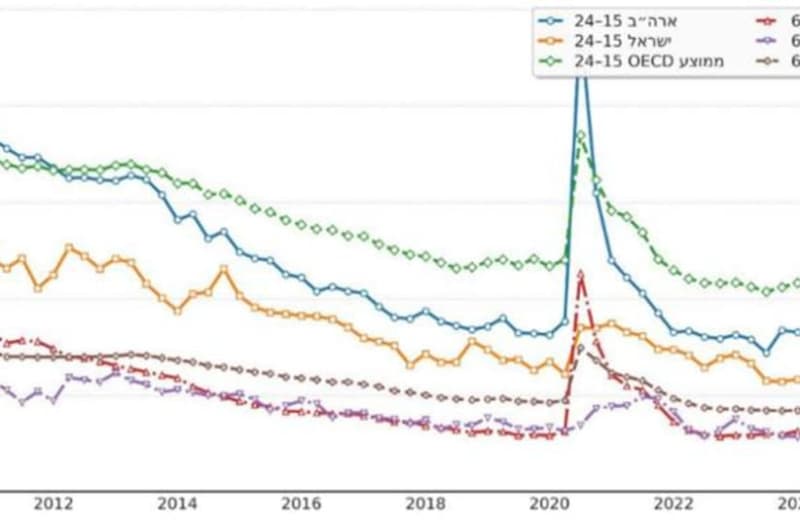
Einbal Mashash, CEO of the Employment Service (photo credit: Osher Photography)
Report reveals declining labor force participation among young Israelis (20-29), especially men and those in the Arab sector. Low unemployment is deceptive, hiding a sharp rise in discouragement.
There has been a gradual, sustained decline in labor force participation and employment rates among young Israelis in 2025, particularly those aged 20-29, a special report by the Israeli Employment Service revealed on Sunday.
While Israel’s low youth unemployment rate has long been a point of pride compared to Western nations, the report suggests th…

Einbal Mashash, CEO of the Employment Service (photo credit: Osher Photography)
Report reveals declining labor force participation among young Israelis (20-29), especially men and those in the Arab sector. Low unemployment is deceptive, hiding a sharp rise in discouragement.
There has been a gradual, sustained decline in labor force participation and employment rates among young Israelis in 2025, particularly those aged 20-29, a special report by the Israeli Employment Service revealed on Sunday.
While Israel’s low youth unemployment rate has long been a point of pride compared to Western nations, the report suggests this figure is deceptive, masking a growing population of young adults who are neither working nor actively seeking employment.
The hidden crisis: Out of the labor force
The data indicates that Israel’s once-high youth labor participation rates have now converged with the OECD average, after a steady decline over the past decade, beginning around 2017.
According to the report, titled “Special Report on the Employment Status of Young People in Israel,” the unemployment rate (which only counts those actively looking for work) remains low at 5.2% for the 15-24 age group, significantly lower than the 10% rate in the US and 11.1% average rate across the OECD in 2025. However, this stability exists because many young people are dropping out of the labor force entirely; they are not counted as unemployed because they are not actively seeking work.
“The decline in young people’s employment rates occurs alongside a welcome rise in the participation of groups that were recently on the fringes of the labor market,” stated Attorney Einbal Mashash, CEO of the Employment Service. “However, this does not undermine the Employment Service’s deep commitment to ensuring optimal employment for all citizens of Israel, including the youth who are the future generation of our economy.”

Graphic on unemployment rate (credit: Courtesy)
Key demographic disparities in Israeli society
The decline is not uniform across all young groups, highlighting a fractured scenario regarding the youth labor market.
Regarding the gender gap, the decline is most pronounced among young men. In 2014, the participation rate for young men (20-24) was approximately 80%, compared to 68% for young women. By 2025, the employment rate for both genders stands at 68%, effectively eliminating the gender gap. The Employment Service speculates this is partly due to an increase in Arab women’s participation.
The rate of those discouraged from seeking work (neither working nor looking) is 2-3 times higher among young people (18-24) than in older age groups and has been increasing. Inside this group, young arabs are discouraged at rates 2-3 times higher than young Jews.
Young men are more discouraged than young women, possibly due to higher wage expectations and a lack of suitable alternatives. This discouragement is most severe in low-skilled occupations such as sales, service, and non-professional roles, suggesting a split labor market in which those starting in low-productivity jobs quickly lose hope.
An aging and divided workforce in Israeli society
The picture for young workers stands in stark contrast to that of their older counterparts.
Employment rates for the prime working-age (25-66) and older adult (55+) populations in Israel continue to rise. They are among the highest in the world, serving as the “employment anchor” for the Israeli economy.
The report also warns that while the current decline is focused on unskilled young men, global trends observed in the US and other Western countries show a consistent rise in unemployment even among highly skilled, educated young professionals (often in high-tech ‘junior’ roles).
The Employment Service suggests this trend may hit Israel following the extended reserve military service during the war, potentially creating a dual challenge: a general withdrawal from the labor force by the ‘weakest’ youth and a reduction in participation by the ‘strongest’ young academics.
Furthermore, the report highlights the potential for these negative trends to be exacerbated by the “massive entry of Artificial Intelligence” into the labor market, which threatens to redefine or eliminate many existing occupations.
Call for national preparedness
The Employment Service stresses the need for national preparedness to address this trend, which represents a significant challenge to the future growth, productivity, and sustainability of the Israeli economy.
The low unemployment figure can no longer be trusted as a sole measure of young people’s connection to the workforce; a deep dive reveals that a large and growing segment of the future generation is disengaging entirely.